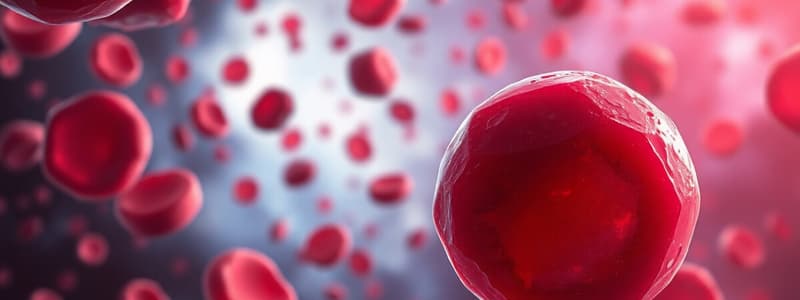Podcast
Questions and Answers
What is the main function of red blood cells?
What is the main function of red blood cells?
- Clotting blood
- Fighting infections
- Carrying nutrients
- Transporting oxygen from the lungs (correct)
Which characteristic allows red blood cells to efficiently exchange gases?
Which characteristic allows red blood cells to efficiently exchange gases?
- Presence of a nucleus
- High iron content
- Biconcave shape (correct)
- Flexibility to fit through capillaries
Where are white blood cells produced and mature?
Where are white blood cells produced and mature?
- Bone marrow and liver
- Liver and spleen
- Red bone marrow and spleen (correct)
- Lungs and bone marrow
What is a unique feature of platelets?
What is a unique feature of platelets?
What distinguishes monocytes from lymphocytes within the white blood cells?
What distinguishes monocytes from lymphocytes within the white blood cells?
Flashcards
Plasma
Plasma
The liquid part of blood that carries nutrients, waste products, and other important substances.
Red Blood Cells (Erythrocytes)
Red Blood Cells (Erythrocytes)
Small, biconcave disc-shaped cells responsible for carrying oxygen throughout the body.
White Blood Cells
White Blood Cells
Cells with a large nucleus that play a crucial role in fighting infections.
Platelets
Platelets
Signup and view all the flashcards
Hemoglobin
Hemoglobin
Signup and view all the flashcards
Study Notes
Blood Composition
- Blood is composed of plasma, red blood cells (erythrocytes), white blood cells (leukocytes), and platelets.
- Erythrocytes are biconcave in shape, maximizing surface area for oxygen exchange.
- They lack a nucleus, impacting their lifespan.
- Erythrocytes contain hemoglobin, transporting oxygen throughout the body.
- Erythrocytes are produced in red bone marrow and broken down in the liver.
- Leukocytes have large nuclei, play a role in fighting infection, and are produced in red bone marrow and mature in the spleen.
- Platelets are cell fragments, crucial for blood clotting.
- Leukocytes are classified into monocytes and lymphocytes, each with specific functions in fighting pathogens.
Red Blood Cells (Erythrocytes)
- Biconcave shape maximizes surface area for oxygen exchange.
- Contain hemoglobin, transporting oxygen.
- Produced in red bone marrow, lifespan is shortened due to no nucleus.
- Flexible for passage through capillaries.
White Blood Cells (Leukocytes)
- Large nuclei, crucial for infection fighting.
- Mature in the spleen, produced in red bone marrow.
- Two categories: monocytes and lymphocytes.
- Monocytes engulf pathogens.
- Lymphocytes are involved in specific immune responses.
Studying That Suits You
Use AI to generate personalized quizzes and flashcards to suit your learning preferences.




